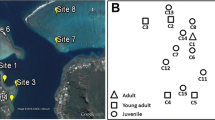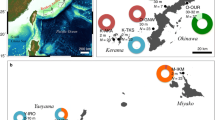Abstract
Siderastrea stellata and S. radians are scleractinian coral species that present a remarkable overlap of diagnostic characteristics and sympatric distribution. Moreover, both are viviparous with similar reproductive strategies and with a gregarious larval behavior. Samples of both species from the Brazilian coast were analyzed using 18 isozymic loci to quantify their genetic variability and populational structure. Results confirmed species identity, high intrapopulational variability and revealed moderate genetic structuring among all samples (S. stellata: F ST = 0.070; S. radians: F ST = 0.092). Based on genotypic diversity analysis, there was evidence that local recruitment may have a minor role in the populations (mean, G o :G e = 1.00 ± 0.0003 SD for S. stellata and 0.99 ± 0.0023 SD for S. radians). Deviations towards heterozygote deficiencies found in both Siderastrea species could be explained by the Wahlund effect, since there was evidence that populations might be composed of colonies of different ages. In S. radians it is also likely that there is some inbreeding occurring in the studied populations. Despite the brooding pattern and the gregarious larval behavior, our data suggest the occurrence of gene flow along the Brazilian coast. This is the first study on population genetics of Brazilian reef corals.

Similar content being viewed by others
References
Alfenas AC, Peters I, Brune W, Passador GC (1991) Eletroforese de Proteínas e Isoenzimas de Fungos e Essências Florestais. Universidade Federal de Viçosa, Viçosa
Ayre DJ, Dufty SL (1994) Restricted gene flow in the viviparous coral Seriatopora hystrix on Australia’s Great Barrier Reef. Evolution 48:1183–1201
Ayre DJ, Hughes TP (2000) Genotypic diversity and gene flow in brooding and spawning corals along the Great Barrier Reef, Australia. Evolution 54:1590–1605
Ayre DJ, Hughes TP, Standish RJ (1997) Genetic differentiation, reproductive mode, and gene flow in the brooding coral Pocillopora damicornis along the Great Barrier Reef, Australia. Mar Ecol Prog Ser 159:175–187
Belkhir K (2001) GENETIX, logiciel sous WindowsTM pour la génétique des populations. Laboratoire Génome et Populations, CNRS UPR 9060. Université de Montpellier II, Montpellier, France
Bengtsson BO (2003) Genetic variation in organisms with sexual and asexual reproduction. J Evol Biol 16:189–199
Brazeau DA, Harvell CD (1994) Genetic structure of local populations and divergence between growth forms in a clonal invertebrate, the Caribbean octocoral Briareum asbestinum. Mar Biol 119:53–60
Budd AF, Guzmán HM (1994) Siderastrea glynni, a new species of scleractinian coral (Cnidaria, Anthozoa) from the Eastern Pacific. Proc Biol Soc Wash 107:591–599
Calderon EN, Castro CB, Pires DO (2000) Natação, assentamento e metamorfose de plânulas do coral Favia gravida Verrill, 1868 (Cnidaria, Scleractinia). Bol Mus Nac Ns zoo 429:1–12
Clayton J, Tetriak D (1972) Amine-citrate buffers for pH control in starch gel electrophoresis. J Fish Res Bd Can 62:1169–1172
Crow JF, Kimura M (1970) An introduction to population genetic theory. Harper and Row, New York
Duerden JE (1904) The coral Siderastrea radians and its postlarval development. Carnegie Institution of Washington, Washington
Forsman ZH, Guzman HM, Chen CA, Fox GE, Wellington GM (2005) An ITS region phylogeny of Siderastrea (Cnidaria: Anthozoa): is S. glynni endangered or introduced? Coral Reefs 24:343–347
Gardner JPA (1992) Null alleles and heterozygote deficiencies among mussels (Mytilus edulis and M. galloprovincialis) of two sympatric populations. Malacologia 34:99–106
Guo SW, Thompson EA (1992) Performing the exact test of Hardy–Weinberg proportion for multiple alleles. Biometrics 48:361–372
Harrison PL, Wallace CC (1990) Reproduction, dispersal and recruitment of scleractinian corals. In: Dubinsky Z (ed) Ecosystems of the world 25: coral reefs. Elsevier, New York, pp 133–207
Hellberg ME (1994) Relationships between inferred levels of gene flow and geographic distance in a philopatric coral, Balanophyllia elegans. Evolution 48:1829–1854
Jokiel PL (1990) Long-distance dispersal by rafting: re-emergence of an old hypothesis. Endeavour 14:66–73
Kimura M, Weiss GH (1964) The stepping stone model of population structure and the decrease of genetic correlation with distance. Genetics 49:561–576
Knowlton N (1994) Sibling species in the sea. Annu Rev Ecol Syst 24:189–216
Laborel J (1974) West African reef corals a hypothesis on their origin. In: Proceedings of the 2nd international coral reef symposium, vol 1. Province, Australia, 22 June–2 July 1973, pp 425–443
Lang JC (1984) Whatever works: the variable importance of skeletal and non-skeletal characters in scleractinian taxonomy. Paleontogr Am 54:18–44
Leão ZMAN, Kikuchi RKP, Testa V (2003) Corals and coral reefs of Brazil. In: Cortés J (ed) Latin American coral reefs. Elsevier Science, New York, pp 9–52
Levin LA, Bridges TS (1995) Pattern and diversity in reproduction and development. In: McEdward L (ed) Ecology of marine invertebrate larvae. CRC Press, Florida, pp 1–48
Lewis PO, Zaykin D (1999) Genetic data analysis: computer program for the analysis of allelic data, version 1.0 (d12). Distributed at http://www.chee.unm.edu/gda
Lewontin RC, Krakauer J (1973). Distribution of gene frequency as a test of the theory of the selective neutrality of polymorphisms. Genetics 74:175–195
Maida M, Ferreira BP (1997) Coral reefs of Brazil: an overview. In: Proceedings of the 8th international coral reef symposium, vol 1. Panama City, 24–29 June 1996, pp 263–274
Márquez LM, Van Oppen MJH, Willis BL, Miller DJ (2002) Sympatric populations of the highly cross-fertile coral species Acropora hyacinthus and Acropora cytherea are genetically distinct. Proc R Soc Lond B 269:1289–1294
McFadden CS (1999) Genetic and taxonomic relationships among Northeatern Atlantic and Mediterranean populations of the soft coral Alcyonum coralloides. Mar Biol 133:171–184
Miller MP (1997) Tools for population genetic analyses (TFPGA) 1.3: a windows program for the analysis of alloenzyme and molecular population genetic data. Free software
Miller KJ, Ayre DJ (2004) The role of sexual and asexual reproduction in structuring high latitude populations of the reef coral Pocillopora damicornis. Heredity 92:557–568
Nei M (1978) Estimation of average heterozygosity and genetic distance from a small number of individuals. Genetics 89:583–590
Neves EG (2004) Complexo Siderastrea: espécies distintas? Significado da variabilidade do gênero Siderastrea de Blainville, 1830 (Anthozoa, Scleractinia) no Brasil. Ph.D. thesis. Universidade de São Paulo, São Paulo
Neves EG, Pires DO (2002) Sexual reproduction of Brazilian Mussismilia hispida (Verrill. 1902). Coral Reefs 21:161–168
Neves EG, da Silveira FL (2003) Release of planulae larvae and settlement behavior of Siderastrea stellata Verrill, 1868 (Anthozoa, Scleractinia), in Brazil. Hydrobiologia 501:139–147
Neves EG, Johnsson R, Sampaio C, Pichon M (2006) The occurrence of Scolymia cubensis in Brazil: revising the problem of the Caribbean solitary mussids. Zootaxa 1366:45–54
Nishikawa A, Sakai K (2005) Genetic connectivity of the scleractinian coral Goniastrea aspera around the Okinawa Islands. Coral Reefs 24:318–323
Ng WC, Morton B (2003) Genetic structure of the scleractinian coral Platygyra sinensis in Hong Kong. Mar Biol 143:963–968
Palumbi SR (2003) Population genetics, demographic connectivity, and the design of marine reserves. Ecol Appl 13(Suppl):S146–S158
Pires DO, Castro CB, Ratto CC (1999) Reef coral reproduction in the Abrolhos reef complex, Brazil: the endemic genus Mussismilia. Mar Biol 135:463–471
Raymond M, Rousset F (1995) GENEPOP (version 1.2): population genetics software for exact tests and ecumenicism. J Hered 86:248–249
Rice WR (1989) Analysing tables of statistical tests. Evolution 43:223–225
Ridgway T (2005) Allozyme electrophoresis still represents a powerful technique in the management of coral reefs. Biodivers Conserv 14:135–149
Ridgway T, Hoegh-Guldberg O, Ayre DJ (2001) Panmixia in Pocillora verrucosa from South Africa. Mar Biol 139:175–181
Shaw CR, Prasad R (1970) Starch gel eletrophoresis of enzymes—a compilation of recipes. Biochem Genet 4:297–320
Smith BL, Potts DC (1987) Clonal and solitary anemones (Anthopleura) of Western North America: population genetics and systematics. Mar Biol 94:537–546
Sokal RR, Rohlf FJ (1995) Biometry, the principles and practice of statistics in biological research. WH Freeman Company, New York
Soong K (1991) Sexual reproductive patterns of shallow-water reef corals in Panama. Bull Mar Sci 49:832–846
Stoddart JA, Taylor JF (1988) Genotypic diversity: estimation and prediction in samples. Genetics 118:705–711
Swofford DL, Selander RB (1981) Biosys-1: a Fortran program for the comprehensive analysis of electrophoretic data in population genetics and systematic. J Hered 72:281–283
Szmant AM (1986) Reproductive ecology of Caribbean reef corals. Coral Reefs 5:43–53
Veron JEN (1995) Corals in space and time. The biogeography and evolution of the Scleractinia. University of New South Wales Press, Sydney
Ward RD, Warwick T (1980) Genetic differentiation in the molluscan species Littorina rudis and L. arcana (Prosobranchia: Littorinidae). Biol J Linn Soc 14:417–428
Weil E, Knowlton N (1994) A multi-character analysis of the Caribbean coral Montastraea annularis (Ellis and Solander, 1786) and its two sibling species, M. faveolata (Ellis and Solander, 1786) and M. franksi (Gregory, 1895). Bull Mar Sci 55:151–175
Weir BS, Cockerham CC (1984) Estimating F-statistics for the analysis of population structure. Evolution 38:1358–1370
Werner TB (1996) Recent zooxanthellate corals (order: Scleractinia) from Ascension and St. Helena Is., South Atlantic, with a summary of their geographic distribution in the Atlantic Ocean. Dissertation. University of Maryland at College Park
Wright S (1969) The evolution and genetics of populations. Vol. 2. The theory of gene frequencies. University of Chicago press, Chicago
Zouros E, Foltz DW (1984) Possible explanations of heterozygote deficiency in bivalve molluscs. Malacologia 25:583–591
Acknowledgments
We would like to thank Dr. Sérgio Mattioli (USP) and Marta Lima (USP) for encouragement in the early assays. We sincerely thank the colleagues of the ‘Laboratório de Diversidade Genética’ (UNICAMP) for the immensurable assistance during gel preparations. We are also grateful to Dr. Rodrigo Johnsson (UFBA) for sustained support throughout the course of this study, and Leila Longo (USP) for her help in field. The authors are also in debt with D. Hewitt, F. F. Jesus and H. Blackhill for English revision. This study was funded by CNPq (no. 140170/2000-6) with scholarship by ‘Pós-Graduação, Área Zoologia, IB-USP’ and the ‘CAPES/PROAP/Instituto de Biociências (USP)/2001–2003’. The authors would like to thank the anonymous reviewers for the suggestions for improving the manuscript.
Author information
Authors and Affiliations
Corresponding author
Additional information
Elizabeth Gerardo Neves and Sónia Cristina S. Andrade contributed equally to this manuscript.
Appendix
Appendix
Rights and permissions
About this article
Cite this article
Neves, E.G., Andrade, S.C.S., da Silveira, F.L. et al. Genetic variation and population structuring in two brooding coral species (Siderastrea stellata and Siderastrea radians) from Brazil. Genetica 132, 243–254 (2008). https://doi.org/10.1007/s10709-007-9168-z
Received:
Accepted:
Published:
Issue Date:
DOI: https://doi.org/10.1007/s10709-007-9168-z




